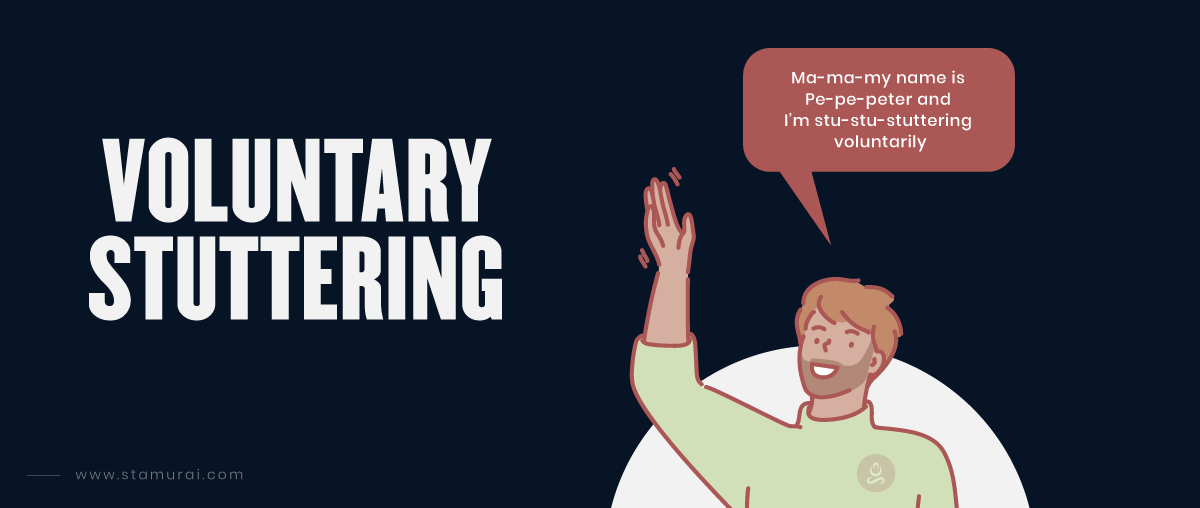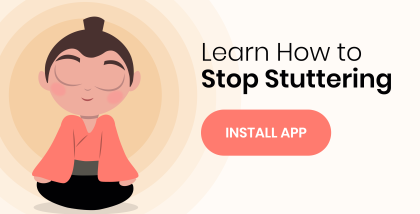For adults, who have been stuttering ever since their childhood, the goal for stuttering treatment isn’t cure. Freedom from stuttering is something every person who stutters wants. However, in most cases of adults who stutter, it is impossible to cure their disfluencies completely.
People who stutter (PWS) have spent a majority of their lives trying not to stutter. They have tried to hide their stutter, they have tried to not talk and they have also Googled “How do I stop stuttering?” a hundred times hoping for a quick cure.
Trying to not stutter hasn’t worked. In fact, trying too hard has only made the stutter worse.
The fact is, if you have stuttered ever since you were a child, you will probably stutter for the rest of your life. So why not make life a little more enjoyable and a lot less tense?

Now, what we are going to tell you might sound a little weird – we are going to ask you to stutter on purpose.
You may wonder how stuttering more can help you stutter less. Isn’t it counterintuitive?
Well, according to the stalwarts of speech-language pathology like Charles Van Riper, Barry Guitar, and Peter Reitzes, voluntary stuttering or clonic pseudo stuttering can give the control of your speech back to you.
What is Voluntary Stuttering?
Voluntary stuttering or clonic pseudo stuttering is defined as a method that involves stuttering on purpose. The person who stutters enters into a conversation with another person with the plan to stutter on every third word. It is typically a monosyllabic repetition that is similar to organic stuttering.
Wendell Johnson (1959) used the term bouncing to refer to the same method. Although, in current practice, speech-language pathologists (SLPs) use the term bouncing to describe another active process to initiate smooth speech.
How Does Voluntary Stuttering Help the Speaker?
Voluntary stuttering is an active process as opposed to DAF, FAF, and choral speaking, which experts refer to as passive stuttering inhibitors. Active pseudostuttering is one of the single most powerful tools that an adult can use.
While it has many purposes, the leading one is to get stuttering out in the open. The person doesn’t have to anticipate a stutter if they plan to stutter on every third word or the beginning of every sentence anyway.
By introducing stuttering at the beginning of the very conversation, the speaker takes control of the narrative. They can control how, where, and when the repetitions occur. It takes out the fear and anxiety of stuttering from the equation completely.

What Goals Can You Set With the Help of Voluntary Stuttering?
Voluntary stuttering may have multiple goals and purposes. These typically depend on the severity of one's stuttering, the age of the person who stutters, and their mental health status.
Stuttering affects more than a person's speech. It can affect a person's self-worth, confidence levels, approach behavior, risk-taking attitude, and personal and professional relationships.
Here are some objectives that stuttering on purpose can meet –
1. Desensitization – You are a good person when you don’t stutter and you are a good person when you do!
Many of us who stutter and have been doing so for decades often try to hide it. We try to hide our stuttering.
For example, we have a list of feared words. We avoid words that begin with hard consonants. Maybe, as a child, we were bullied incessantly because we used to get stuck on words beginning with /b/. Now, we put in conscious effort to avoid all words that begin with /b/.
It takes a toll on our communication skills since finding a synonym with the exact meaning and nuances is not always possible. We often choose to remain quiet even when we want to speak for the fear of stuttering.
When you take up voluntary stuttering, you may choose to stutter on the first word of every sentence, whether it starts with /b/ or not. Stutter noticeably, and boldly. You can couple your pseudostuttering with voluntary eye blinking, head nodding, or hand movements.
We often feel that we have little control over our speech. After practicing voluntary stuttering for a while, you may begin to realize that you have control over your speech after all. Stuttering is a natural part of your speech. There is no reason to fear it or hide it.
Voluntary stuttering can help you create a new self-image. The transformation from a person avoiding and hiding stuttering to proudly brandishing it is entirely possible.
It may take a month for some, or three months for others, but clonic pseudo stuttering can give you a taste of freedom from the fear of stuttering like no other active speech therapy technique.

2. Moving forward with one’s speech – It’s not important how many times you get stuck; it’s important to keep moving
Easy stuttering can allow you to move past a moment of blocking and intense repetition. It is a form of stuttering modification that uses voluntary stuttering to begin a feared word.
For example – you are aware that you will get stuck on the /b/ of “buds”. Speech therapists recommend easing into the word by prolonging the /b/ sound and initiating the next vowel to move forward.
However, the struggle is very different for those who stutter. People who stutter tend to feel confused, angry, and frustrated when they find themselves stuck. Applying such speech modification techniques becomes almost impossible when one is unable to think. Hence, applying the common techniques for reducing stuttering may be challenging during an ongoing repetition.
Voluntary stuttering can prepare you for such situations. Instead of feeling overwhelmed with anger, frustration, and shame, you may be able to find the calmness to apply subsequent techniques necessary to get out of the stutter and move forward with your speech.
Clonic pseudostuttering will help you apply easy onsets, pull-outs, and bouncing like techniques to your speech for moving smoothly through the moments of stutter.
3. Building listening skills – Own your stutter to listen to others
During many instances of particularly severe stuttering, we become so focused on our own speech that we forget to listen to what others are saying.
When you become accustomed to stuttering after stuttering-on-purpose for weeks or months, your own stutter may bother you less than before. It will allow you to focus on things other than your own speech disfluencies.
You will not only be able to listen to what others are telling you, but also find participating in conversations more rewarding.
Your self-doubt will take a backseat. That is when you will truly become aware of your role and importance in a meeting, group discussion, or a casual conversation.
4. Overcoming the shame of stuttering – Give yourself the power to control narratives
Stuttering and shame have shared a strong bond. Whether it’s a teenager or an adult, they know shame all too well, if they have been stuttering since childhood.
Shame keeps us from achieving our true potential. It stops us from taking chances in life.
People who stutter rarely maintain eye contact while speaking. We tend to look away or look at the listener’s hands or feet when a stutter sets in. That also conveys to the listener that stuttering is something shameful – one should look away during a moment of disfluency.
Humans mimic each other’s body language to a great extent during a conversation. Voluntary stuttering gives you the chance to take control of the situation. If you are not ashamed of stuttering, it shows the listener that they shouldn’t look away either.
It is a powerful tool that may change how your listener perceives your stuttering and speech. You can set the comfort level by entering a conversation to stutter on purpose. That will take away the power of the real stutters when they occur.
5. Reducing stuttering – The ulterior motive of every stuttering therapy tool
Voluntary stuttering can reduce actual stuttering. One of the most famous accounts comes from Lon L. Emerick. According to Emerick, the more one stutters on purpose the less they are likely to hold back. That makes them unlikely to stutter severely.
His team once worked with an exchange student who almost overcame her stuttering in less than a week. All she did was meet and greet 947 people in less than seven days and stuttered all she could. By the end of that week, she was exhausted, but she could no longer stutter!
While that is a one-of-a-kind incident, it is entirely possible to at least reduce one’s stutter by engaging in the practice of pseudostuttering.
According to accounts presented by Peter Reitzes, people have reported that their real stutter became less or almost disappeared when they practiced voluntary stuttering for weeks. He believes that it is the diminished fear and apprehension that contributes to a significant reduction in the frequency of one’s stuttering.
How To Incorporate Voluntary Stuttering in Daily Conversations?
How you stutter voluntarily will have a massive impact on the benefits you enjoy. Studies by Byrd et al (2016) show that clients experience more benefits from clonic pseudostuttering when they try to match it closely to their actual stuttering.
At the same time, the clients who enjoyed maximum benefits were the ones who employed voluntary stuttering outside a clinical environment.
First, decide how you are going to apply the technique. If you have a problem with your /d/, /b/ and /k/ think about stuttering on every other hard consonant like /p/, /t/ and /s/.
You can also decide to stutter at the start of every sentence that begins with a hard consonant.
Here are some situations where you can apply voluntary stuttering –
- While ordering food – always try to ask a question or inquire about a particular dish.
- During a lecture or a meeting ask pertinent questions.
- Answer your phone at least thrice a day. If you don't get calls, call a friend, family member, or a supermarket. Talk boldly complete with voluntary stutters.
- While traveling by bus or the subway, ask a complete stranger what the next stop is.
- While eating out, thank the waiter/waitress for their service.
- Talk to your family about voluntary stuttering while applying the technique.
- Meet your friends or make a Zoom call and tell them about your latest venture.

Are You Practicing Voluntary Stuttering Correctly?
The first step to enjoying the benefits of voluntary stuttering is accepting your stutter. Once you stop putting in the immense effort necessary to hide your stutter, you will find a sense of liberation and empowerment.
Next, you need to start stuttering boldly, noticeably, and in a manner similar to your real stutter. Cheating by stuttering softly, or almost inaudibly doesn't yield favorable results.
Practicing pseudostuttering only in front of the SLP is not enough. You need to extend your voluntary stuttering practice to real conversations outside your current comfort zone.
Set short-term goals for yourself. For example – "today I will voluntarily stutter in front of 5 people". Note down your experience, feelings, and perceptions from Day #1. You can track your progress in a journal. Or, you can use an app like Stamurai to monitor your stuttering goals and fluency.
Talk to your SLP and cognitive-behavioral therapist about how your perceptions about stuttering are gradually changing as you master voluntary stuttering.
For some it takes a mere month, for others, it may take half-a-year. Nonetheless, the positive impact of voluntary stuttering is inevitable, especially when you are working with a speech therapist.










